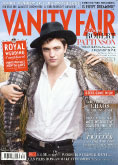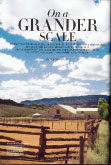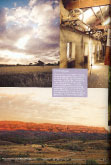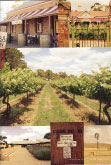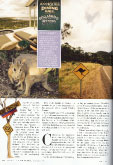Vanity Fair | April 2011
On A Grander Scale
Forget your Rough Guide. What you’ll really need is a Thesaurus because the landscapes of South Australia will soon have you racking your brain for alternative to “huge”, “amazing”, “awesome” and “wowee”.
By Marion Hume
Do not go to South Australia because you want to climb the Harbour Bridge, watch the sun rise over Uluru or find Nemo on the Great Barrier Reef. None of these are in South Australia, where you can’t even crack a convict joke in the state capital of Adelaide without someone pointing the sugar tongs and reminding you that there was never any of that transported unpleasantness around here — it was free-settled in accordance to an 1834 Act of His Majesty’s Parliament. But do go to South Australia, because it will blow your mind.
One and a half times the size of Texas, think of it as a perpetual version of the artist James Turrell’s Bindu Shards, the mysterious hi-tech installation that packed them in at London’s Gagosian Gallery in late 2010 — except out here you won’t have to clamber inside a metal pod in order to witness Technicolor dreams so intense they’re freaky. You’ll feel utterly alone as dawn breaks over the Finders rangers and they pump up the lights. Sure, waking up on the other side of the state line at Uluru (Ayers Rock if you’re not keeping up) is impressive, until someone slurps from a Thermos. But what’s different here is you can’t capture this on a postcard because the immensity makes it photographically impossible.
It’s as if the Zen principles of the Japanese garden have been turned upside down. Every rock in the foreground could be a mountain in the distance — your brain can’t compute the dimensions of the empty space in between, especially without the migratory herds of the African plains on which to lock your viewfinder. Still, look down and there could be a king brown snake, dull-looking but deadly, about to slither up under the axle of your car.
To explore here is both a sensory pleasure — such a cluster of world-class wineries — and a tease. Let’s say you are doing a quick edit of your digital snaps. What you see are Alpine slopes. Where you are is on a bluff bleached by the sun where the pines have shed their needles. Then there’s your ears, which hear the crackle of footsteps on a frosty lawn while your eyes spy kangaroo-paw prints on the salty crust of what was once the ocean floor.
But before we get into the outback, just an hour or so out of Adelaide is the Barossa Valley. Most of its early settlers were Lutherans fleeing religious persecution in Prussia, who thoughtfully stuffed some vines in their bags as they decamped from South Australia.
If you intend to sample the Shiraz, you must stay at The Louise. No you must stay at The Louise — Australia’s drink-driving laws are among the toughest in the world. Then you can also experience the delight of an outdoor shower, before dinner at Appellation, where grilled wagyu mignon wrapped in prosciutto with bacon crumble and creamed white beans convinces you that it is justly renowned.
Another day, another valley of vines, although there aren’t many wineries like Sevenhill Cellars, which has the lay market and the church trade stitched up (the latter is shifting from reds to whites to save on laundering the alter cloths). North Bundaleer, built at the end of the 19th century, sits where the Clare Valley ends. This gracious homestead was built for George Maslin, a sheep farmer made good, so there’s a ballroom under the corrugated-iron roof.
Of course, this being Australia, some things are just odd. So you don’t blink when a bloke looks up from under the brim of his Akubra and says his semen price is $60 a dose. He’s talking about his stud ram. And the man in raggedy trousers, leaning on a gate forged out of an old iron bedstead? He only looks like a Depression-era portrait by Dorothea Lange until his iPhone beeps with the Tokyo trading price for sushi-grade abalone, for which he owns a brace of offshore dive licenses. After hours on a bullet-straight road, you’re in a pub and the waitress reappears, cradling a small goat, to offer condom pie for afters. Ah, that would be quandong, a native plum.
Arriving into the little former railway town of Quorn feels like high noon in the Wild West, due to its streets as wide as a movie set-which is what is has been since Maureen O’Hara showed up in the 50s, followed by Robert Mitchum and Deborah Kerr in the 60s, and then Mel Gibson, who shot scenes for Gallipoli here in 1980, back when he was still beautiful.
There was a camel in Gallipoli; in fact there have been camels in South Australia since 1840. Today there are over a million feral dromedaries roaming the country, descended from those that hauled anything from telegraph cables to the sleepers for the Ghan railway — “Ghan” being short for “Afghan”, a catch-all term for Muslim cameleers. Surnames deriving from Muscat, Yemen and Iraq pepper South Australia. Look hard enough and somewhere you’ll find camel pie.
Arkaba is one of the Luxury Lodges of Australia-Which also include The Louise, the divine Capella off the coast of New South Wales and the new Saffire in Tasmania, as well as Southern Ocean Lodge on Kangaroo Island, of which more in due course. It’s a spirited initiative to trump the successful superlodges of New Zealand. Arkaba’s owner, Charlie Carlow, heir to the earldom of Portarlington, explains: “We are not trying to recreate hotel rooms with mini-bars. Here you just help yourself to drinks- it’s like staying in someone’s home. This is an early settler property, and the original owner had some kind of eating house or pub-there’s an Eating House Creek nearby. Graveyards on the property tell of heroic failures.” The bedheads are made of old fence posts, bed-side tables are glass-topped wool bales and communal dining is round an old wool-sorting table.
Most of all, though, at Arkaba it is possible to get some perspective on the landscape of the rugged Flinders Ranges.
Every August since 1856 professional or “gun” shearers have shown up to work at the Arkaba woolshed, which looks just like the one in Tom Robert’s 19th century masterpiece, Shearing the Rams, a painting that defines a certain strand of Australian art that is at once masculine and misty.
Collectively, the traditional inhabitants of the Flinders Ranges are known as the Adnyamathanha, the hill people. But even the ancient Aboriginal tribes are, in geological terms, johnny-come-latelys in a wonderland that dates back some 1.8 billion years.
Further north, things get more exciting as they get younger (about 550 million years). Because so few people kick about in the Ediacara Hills, no one picked up the key to life until 2003, after which Ross Fargher, whose family own the Prairie Hotel, Parachilna, left his fossil lying on the porch until a palaeontologist realised it beat that of the next oldest vertebrae by 30 million years. No wonder David Attenborough gets breathless when he visits.
When I was editing Vogue Australia, I sent a fashion team to the Prairie Hotel, where the time is always beer o’clock and there’s fancy fayre like wallaby shashlick and emu-egg frittata on the menu. They drove out into the middle of nowhere and just at the model was striking a pose a voice hollered, “Oi! I’ve just raked that!” And then Kate Winslet and Harvey Keitel appeared to shoot a scene for Jane Campion’s Holy Smoke.
Take a small plane south and meet me on Kangaroo Island. You’re still in the same state, but it’s too far to drive unless you’ve got time on your hands.
So you’ve ticked off the African Safari big five? Pens at the ready for an Aussie Noah’s Ark, because this island, eight miles offshore from Cape Jervis, is a natural life raft for endangered creatures, including the Australian sea lion- the world’s more threatened pinniped- and the glossy black cockatoo. It is also where the Heath goanna is making its last stand. Then there’s the New Zealand fur seal, the Tammar wallaby (the wallaby and the kangaroo are cousins) and Koalas (never, please, “koala bears” they’re not bears), which are increasingly rare on much of the mainland- but look, there’s one now, in his furry pyjamas.
How adorable are the waddling squadrons of fairy penguins! As for mail-order queens, genetically pure K.I bees are in demand by international apiarists. But just because there are no foxes, no rabbits, to destroy this Antipodean Galapagos doesn’t mean there’s nothing that can kill you. “Gotcha!” hisses the tiger snake, and you sincerely hope it’s joking- one bite and, without antivenom, odds on you’re a goner.
And so to the four-headed penis of the male short-beaked echidna, which isn’t enough for the female that looks like a porcupine but makes like a princess as she leads up to eight randy chaps on a six- week Animal Magic excursion called an echidna (love) train, at the end of which only one gets a shag. About 24 days later, mama lays an egg, which she wiggles up into her pouch, where it stays until it hatches into a puggle. It’s knowledge like that which makes you wish Trivial Pursuit had not gone the way of the Victorian parlour game.
Egg-laying monotremes are the oldest surviving mammals on Earth, and if that isn’t enough to get an island named after you, blame Captain Matthew Finders, who was starving when he and his men landed in 1802 and threw roos in the pot. Nicholas Baudin, who made landfall that same spring, was French, so he nabbed a kangaroo to parade around Paris- though he (the Frenchman) only made it to Madagascar before he died. Both explorers must surely have been surprised that they encountered no Aboriginal people on an island seven times the size of Singapore. Nor has an Aboriginal skeleton been found since. Tools dating back 16,000 years suggests that whoever did live here was fending off marsupial Godzillas- possums and wombats the size of rhinos- so may have made a dash for it over a long-gone land bridge.
I won’t be surprised if you already know about Southern Ocean Lodge, given it has won just about every travel gong going since it opened in 2008. Why will be particularly clear if your billet is the exhilarating Osprey Suite, with its peerless glass-walled views over the pounding surf. You’d expect this game-changing luxury lodge, which slithers almost invisibly down a bluff, to be eco-this, eco-that. It is also near-carbon-neutral, what with crab-meat omelette for breakfast, line-caught snapper for lunch, and dinner’s oysters followed by South Rock lamb, all locally-sourced. The Henschke Julius Riesling, however, had to travel from the Barossa Valley.
You’ll be glad it did, and you did, as you stand at sunset, glass in hand, for kangaroos and canapés and a mob of roos bounds across the horizon.

